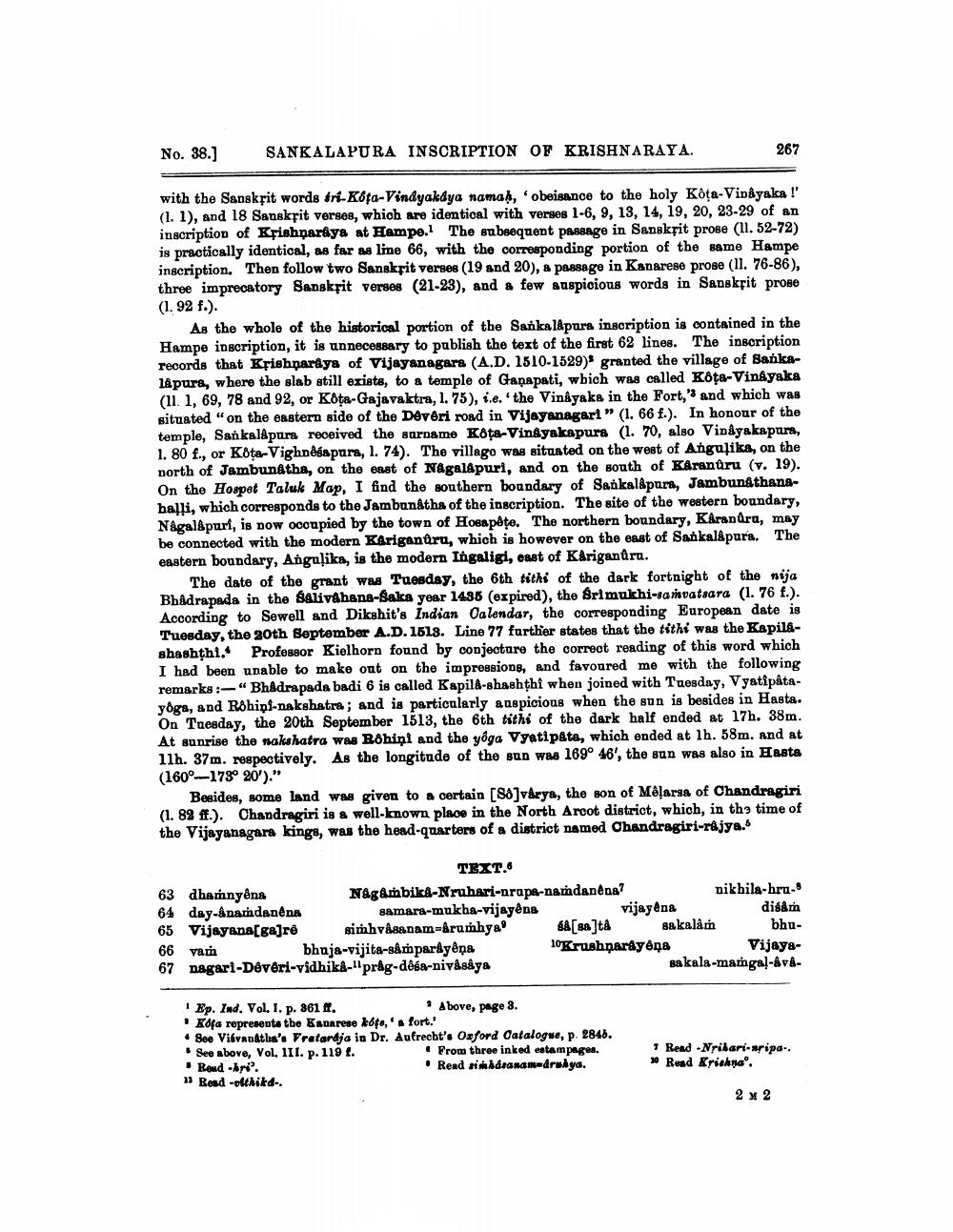________________
No. 38.]
SANKALAPURA INSCRIPTION OF KRISHNARAYA.
267
with the Sanskrit words tri-Kota-Vindyakdya namah, obeisance to the holy Kota-Vinayaka !' (1.1), and 18 Sanskrit verses, which are identical with verses 1-6, 9, 13, 14, 19, 20, 23-29 of an inscription of Krishnaraya at Hampe. The subsequent passage in Sanskrit prose (11.52-72) is practically identical, as far as line 66, with the corresponding portion of the same Hampe inscription. Then follow two Sanskrit verses (19 and 20), a passage in Kanarese prose (11. 76-86), three imprecatory Sanskrit verses (21-23), and a few suspicious words in Sanskrit prose (1.92 f.).
As the whole of the historical portion of the Sankalápara inscription is contained in the Hampe inscription, it is unnecessary to publish the text of the first 62 lines. The inscription records that Krishnaraya of Vijayanagara (A.D. 1510-1529)' granted the village of Sankalå pura, where the slab still exists, to a temple of Ganapati, wbich was called Kôte-Viniyaka (11. 1, 69, 78 and 92, or Kota-Gajavaktra, 1.75), i.e. the Vinayaka in the Fort,' and which was situated "on the eastern side of the Devēri road in Vijayanagari" (1. 66 f.). In honour of the temple, Sankal&purs received the surname Kota-Vinayakapura (1. 70, also Vinayakapura, 1. 80 f., or Kota-Vighnesapara, 1. 74). The villago was situated on the west of Angulika, on the north of Jambunatha, on the east of Nagal&puri, and on the south of KAranúru (v. 19). On the Hospet Taluk Map, I find the southern boundary of Sankalapura, Jambunathanahalli, which corresponds to the Jambunaths of the inscription. The site of the western boundary, Negalapuri, is now occupied by the town of Hosapête. The northern boundary, Káranura, may be connected with the modern Karigandru, which is however on the east of Sankal&pura. The eastern boundary, Angaļika, is the modern Ingaligi, oast of Karigandru.
The date of the grant was Tuesday, the 6th tithi of the dark fortnight of the nija BhAdrapada in the salivahana-Saka year 1435 (expired), the Srimukhi-sanovatsara (1.76 f.). According to Sewell and Dikshit's Indian Oalendar, the corresponding European date is Tuesday, the 20th September A.D. 1518. Line 77 further states that the tithi was the Kapilishashthi.. Professor Kielhorn found by conjecture the correct reading of this word which I had been unable to make out on the impressione, and favoured me with the following remarks:-“ Bhadrapada badi 6 is called Kapild-Bhashthi when joined with Tuesday, Vyatipåtayoga, and Rəhipi nakshatra, and is particularly auspicious when the sun is besides in Hasta. On Tuesday, the 20th September 1513, the 6th tithi of the dark half ended at 17h. 38m. At sunrise the nakshatra was Bhiņi and the yoga Vyati påta, which ended at lh. 58m. and at 11h. 37m. respectively. As the longitude of the sun was 169° 46', the sun was also in Hasta (160°-173° 20')."
Besides, some land was given to a certain [88]v&rya, the son of Mêlarga of Chandragiri (1. 82 ff.). Chandragiri is a well-known place in the North Aroot district, which, in the time of the Vijayanagara kings, was the head-quarters of a district named Chandragiri-rajya.
TEXT. 63 dhamnyêng Någ ambika-Nrubari-nrapa-namdanena?
nikhila-hru. 64 day-&nardanena samara-mukha-vijayêna
vijayena
disam 65 Vijayana[ga]ré simhvâsanam-arumhya SA[sa]tà sakalam bhu66 vam bhaja-vijita-sâmpardyêņa
10 Krushnarayona
Vijays67 nagari-Devēri-vidhika-prag-doba-nivasaya
sa kala-mamga!-&ve
Ep. Ind. Vol. 1. p. 861 f.
Above, page 3. Kófa representa tbe Kanarese kote, a fort.' • See Visvanatha'. Fratardja in Dr. Aufrecht's Oxford Catalogue, p. 2840. See above, Vol. 111. p. 119 t.
• Prom three inked estampages. .Rendbri.
• Read masanamedrudya. 1 Road -olthikd-.
1 Read - Nribari-aripa.. * Read Krishna
2 x 2




